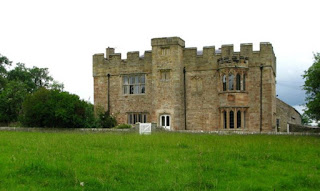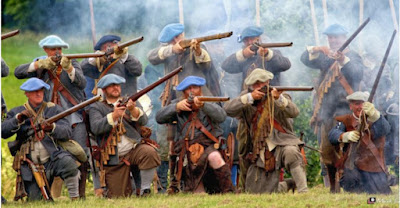In the early days of 1648 news would come to Hipswell of rebellions and fighting. The Christmas riots were turning into rebellions, Royalists in Wales had risen, Royalist commanders had taken Berwick and Carlisle and the fleet had mutinied.
In the very cold, wet weeks of July 1648, the people of Teesdale and Richmondshire realised fighting was coming closer to home. A Scottish army had crossed into England on 8 July and was quartered at Penrith and Appleby, waiting for reinforcements. And this time they had invaded to support the King – and this time he had agreed, after secret negotiations with one of the Scottish factions, that he would impose Presbyterianism on the English if they would put him back on his throne. Finally he had his army – Scots, English and Welsh Royalists, Scots Covenanters and some English Presbyterians.
When this was realisesd, what were people to think? It must have been baffling and unsettling. The King's attempt to impose his Anglicanism on the Presbyterian Scots had started the wars in the first place, all those years ago. For the Wandesfords, their Anglican religion and their King were inseparable and they longed to be rid of the Presbyterian minister forced on them at Kirklington. Did the King mean to keep his word to the Scots? And if he didn't, what would happen?
Sir Thomas Danby had given his word not to take up arms against Parliament when he got his sequestered estates back, so for him and men like him the only honourable option was to stay at home and await events. George Wandesford had a choice. His property was still sequestered and he had made no promise. But he decided not to risk his family's safety and security to join with a Scottish army – the last people he would have wanted to join and possibly the very men who had been quartered on them at Hipswell – for a possibly doomed attempt at defeating Parliament.
Then a Parliamentary army of 4,000 men under the able and decisive young Major-General John Lambert of Kirkby Malhamdale arrived to garrison Barnard Castle. They were waiting to meet the Scots, expecting them to cross Stainmore on their way to Pontefract Castle, which Royalists had retaken for the king.
 |
| General John Lambert (1619-84) |
But there was no sign of the Scots – they had moved south, not east. And their timing was all wrong – the rebellions and the invasion hadn't coincided. By the time the Scots set off towards Cheshire, Oliver Cromwell had taken the surrender of Pembroke Castle and was on his way north. General Lambert marched his men south and met Cromwell at Wetherby. They now had about 9,000 men, half the strength of the Royalists.
The weather was terrible, the armies made slow progress. The Scots were short of supplies and they were getting no reinforcements from the English as they passed. Cromwell crossed the Pennines via Skipton at speed and, catching the Royalists by surprise, he took Preston. After grim fighting for two hours, his men drove across the Ribble bridge at push of pike, driving the Scots from the bridge over the River Darwen soon after. In wind and driving rain, the Scots continued south in the mud, exhausted and demoralised. Wigan, the town that had welcomed the Wandesfords so kindly in 1643, was plundered violently by hungry Scots soldiers, even though it had always been a Royalist town. Their goal had been Warrington, where they hoped for reinforcements from Cheshire and Wales. Their attempt ended instead on 19 August with surrender and imprisonment for many, escape for some – and execution for their commander, the Duke of Hamilton.
 |
| Charles I at his trial |
The attempt to restore Charles to the throne had failed. Now the radicals in power in the Army and Parliament had run out of options with him. The King – that Man of Blood, as they called him – had brought Scottish troops into England and set off another civil war. More death, more destruction. His slipperiness and dubious intrigues made further negotiations impossible. They put him on trial for high treason as an enemy of the people. And now he rose to the occasion – never in his life had he behaved with such quiet dignity. The outcome was a foregone conclusion. He was declared guilty and 59 of the 68 commissioners who sat in judgement signed the death warrant – one of them was Thomas Chaloner of Guisborough.
Charles was executed on 30 January 1649 in Whitehall, on a scaffold outside the Banqueting House where the glorious ceilings he had commissioned Rubens to paint celebrated the belief in the Divine Rule of Kings that he and his father had held so dear.
 |
| The execution of Charles I |
The shock to his supporters was dreadful. The Annointed of the Lord, the Joy of our hearts, the light of our eyes had been cruelly murdered, wrote Alice, by blasphemous rebels. And not just to his supporters – the execution of the king by an army faction was deeply unsettling and at the moment of his death, when a groan went up from the silent watchers, the cult of King Charles the Martyr was born.
Note
This was the end of the Second Civil War, 1648
The English Republic and the invasion of Scotland: 1650
England was now a republic and soon Parliament declared it was a Commonwealth – the traditional word for a community founded on the common good of all. But they had executed the king without consulting the Scottish parliament, and Charles was not only king of England but king of the Scots as well. Within days of the execution, the Scots proclaimed his son as King.
While Oliver Cromwell crushed radical mutinies in the army and crossed to Ireland to subdue it with the utmost brutality, the new king Charles II – not yet nineteen years old – went into an alliance with the Scottish Presbyterians, promising, like his father before him, to impose Presbyterianism on the English.
 |
| Charles II c1650, by Adriaen Hanneman |
Now the English Council of State decided to preempt a Scottish invasion by invading Scotland.
In the middle of July 1650, a large army of some 15,000 men marched through Yorkshire on its way to Durham. It reached Berwick-upon-Tweed on 19 July. Oliver Cromwell was in command. It was another particularly wet, cold summer, and the Scottish commander hoped that sickness and hunger would wear the English down, so he destroyed all the crops and removed all the livestock between the border and Edinburgh.
Cromwell began by trying to persuade the Scots that young Charles was not a fitting king for them – they were beginning to have their doubts about this charismatic and dashing young man, but Charles was ready to promise them anything and they were not to be persuaded by an invading English general. It looked as though the Scottish army would succeed triumphantly, but in heavy rain, in sodden fields, it went down to a crushing and surprising defeat at the Battle of Dunbar on 3 September 1650. It was Cromwell's greatest victory.
On Christmas Eve, Edinburgh surrendered to Cromwell. On New Year's Day 1651, the Scots crowned Charles II at Scone in Perthshire.
Note: the Scottish prisoners in Durham Cathedral
Cromwell was left with a lot of prisoners on his hands after the Battle of Dunbar and he wanted to advance further into Scotland. He sent 3,900 of them south. By the time they reached Durham, after an eight day march, some had escaped, some had been shot, and some had died of disease. The rest – 3,000 of them – were locked inside the disused cathedral at Durham because it was the only place big enough to take them and the Parliamentarians didn't think of churches as sacred spaces anyway. Conditions got out of control when the bloody flux – dysentery – took hold, and 1,600 were dead within six weeks. Of the rest, some were sent to work in Sir Arthur Haselrigge's coal mines and in local industry, and some were sent at indentured servants to Massachusetts. The last were set free in July 1652. Their story was never forgotten in Durham. It made the news when bodies were discovered in the grounds of the cathedral square in 2013 and again in 2018 when the results of painstaking investigation were published. See here for a full account.




















